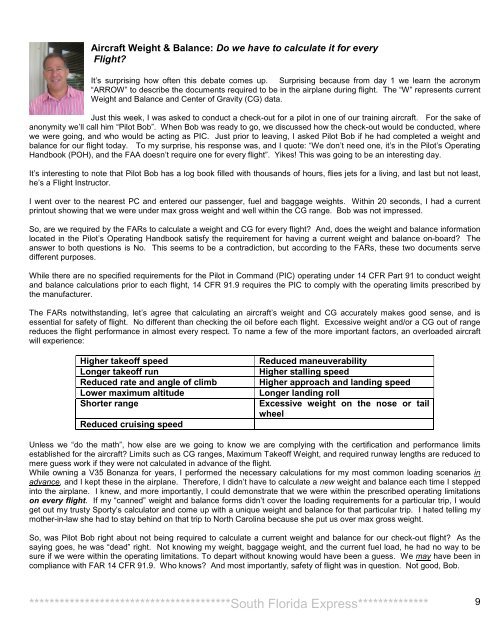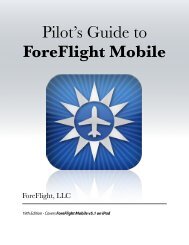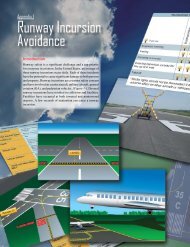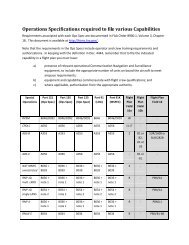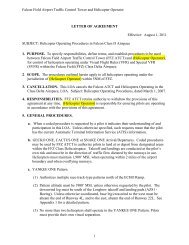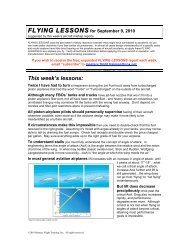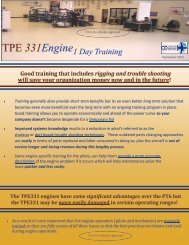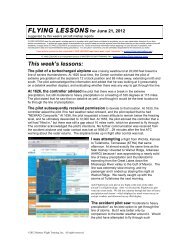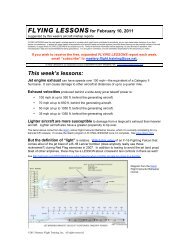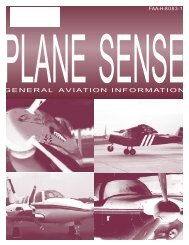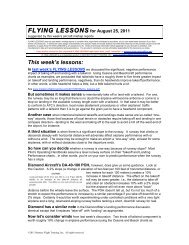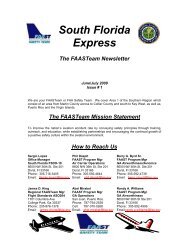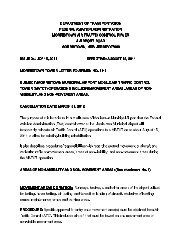South Florida Express The FAASTeam Newsletter - FAASafety.gov
South Florida Express The FAASTeam Newsletter - FAASafety.gov
South Florida Express The FAASTeam Newsletter - FAASafety.gov
You also want an ePaper? Increase the reach of your titles
YUMPU automatically turns print PDFs into web optimized ePapers that Google loves.
Aircraft Weight & Balance: Do we have to calculate it for every<br />
Flight?<br />
It’s surprising how often this debate comes up. Surprising because from day 1 we learn the acronym<br />
“ARROW” to describe the documents required to be in the airplane during flight. <strong>The</strong> “W” represents current<br />
Weight and Balance and Center of Gravity (CG) data.<br />
Just this week, I was asked to conduct a check-out for a pilot in one of our training aircraft. For the sake of<br />
anonymity we’ll call him “Pilot Bob”. When Bob was ready to go, we discussed how the check-out would be conducted, where<br />
we were going, and who would be acting as PIC. Just prior to leaving, I asked Pilot Bob if he had completed a weight and<br />
balance for our flight today. To my surprise, his response was, and I quote: “We don’t need one, it’s in the Pilot’s Operating<br />
Handbook (POH), and the FAA doesn’t require one for every flight”. Yikes! This was going to be an interesting day.<br />
It’s interesting to note that Pilot Bob has a log book filled with thousands of hours, flies jets for a living, and last but not least,<br />
he’s a Flight Instructor.<br />
I went over to the nearest PC and entered our passenger, fuel and baggage weights. Within 20 seconds, I had a current<br />
printout showing that we were under max gross weight and well within the CG range. Bob was not impressed.<br />
So, are we required by the FARs to calculate a weight and CG for every flight? And, does the weight and balance information<br />
located in the Pilot’s Operating Handbook satisfy the requirement for having a current weight and balance on-board? <strong>The</strong><br />
answer to both questions is No. This seems to be a contradiction, but according to the FARs, these two documents serve<br />
different purposes.<br />
While there are no specified requirements for the Pilot in Command (PIC) operating under 14 CFR Part 91 to conduct weight<br />
and balance calculations prior to each flight, 14 CFR 91.9 requires the PIC to comply with the operating limits prescribed by<br />
the manufacturer.<br />
<strong>The</strong> FARs notwithstanding, let’s agree that calculating an aircraft’s weight and CG accurately makes good sense, and is<br />
essential for safety of flight. No different than checking the oil before each flight. Excessive weight and/or a CG out of range<br />
reduces the flight performance in almost every respect. To name a few of the more important factors, an overloaded aircraft<br />
will experience:<br />
Higher takeoff speed Reduced maneuverability<br />
Longer takeoff run Higher stalling speed<br />
Reduced rate and angle of climb Higher approach and landing speed<br />
Lower maximum altitude Longer landing roll<br />
Shorter range Excessive weight on the nose or tail<br />
wheel<br />
Reduced cruising speed<br />
Unless we “do the math”, how else are we going to know we are complying with the certification and performance limits<br />
established for the aircraft? Limits such as CG ranges, Maximum Takeoff Weight, and required runway lengths are reduced to<br />
mere guess work if they were not calculated in advance of the flight.<br />
While owning a V35 Bonanza for years, I performed the necessary calculations for my most common loading scenarios in<br />
advance, and I kept these in the airplane. <strong>The</strong>refore, I didn’t have to calculate a new weight and balance each time I stepped<br />
into the airplane. I knew, and more importantly, I could demonstrate that we were within the prescribed operating limitations<br />
on every flight. If my “canned” weight and balance forms didn’t cover the loading requirements for a particular trip, I would<br />
get out my trusty Sporty’s calculator and come up with a unique weight and balance for that particular trip. I hated telling my<br />
mother-in-law she had to stay behind on that trip to North Carolina because she put us over max gross weight.<br />
So, was Pilot Bob right about not being required to calculate a current weight and balance for our check-out flight? As the<br />
saying goes, he was “dead” right. Not knowing my weight, baggage weight, and the current fuel load, he had no way to be<br />
sure if we were within the operating limitations. To depart without knowing would have been a guess. We may have been in<br />
compliance with FAR 14 CFR 91.9. Who knows? And most importantly, safety of flight was in question. Not good, Bob.<br />
****************************************<strong>South</strong> <strong>Florida</strong> <strong>Express</strong>**************<br />
9


